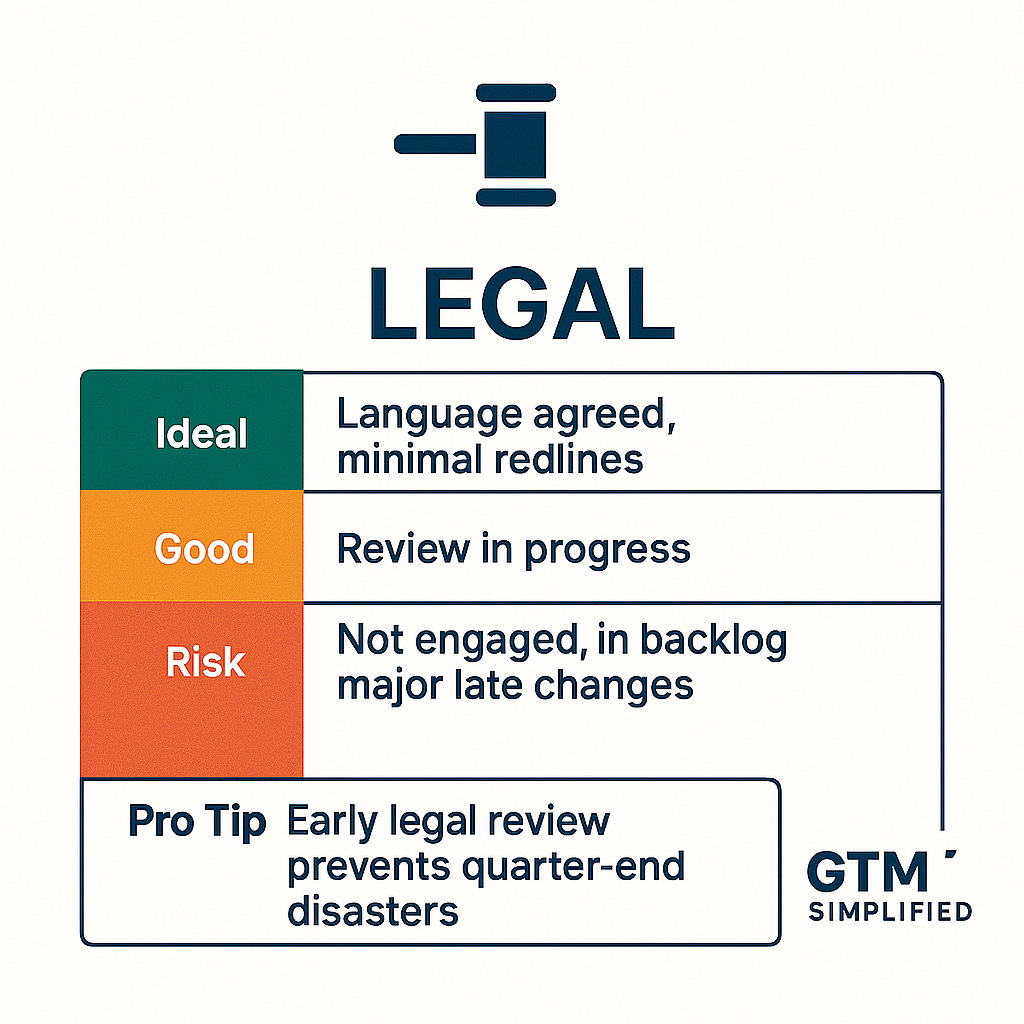🚦 Why Your Enterprise Deals Stall (and How to Keep Them Green)
The 6 decision centers you must win.
Enterprise sales isn’t just about winning a champion.
It’s about navigating a hidden system inside your customer’s org — a system that decides whether you get the signature or watch the deal slip into next quarter.
That system has six decision centers.
Miss one, and you will get stuck.
In this playbook, I’ll show you:
The exact sequence that works.
How to score each center as Ideal, Good, or Risk.
Why 4 greens and no reds is the rule before you forecast “commit.”
Why This Framework Exists
Over the years, I’ve seen the same deal-killers over and over again:
Procurement getting brought in late and stopping everything.
Security review starting after pricing is agreed, adding 90 days.
An executive sponsor backing a competitor.
IT raising architectural objections after you’re verbally “approved.”
The problem isn’t lack of skill. The problem is missing a complete map of the buying system and knowing how to sequence and measure your progress through it.
That’s why this framework breaks deals down into:
Six decision centers you must win.
The sequence that works best.
A status scoring model — Ideal / Good / Risk — to track deal health.
1. Executive Sponsor
Ideal (Green): Budget owner or above. Actively engaged with your executives. Has intervened to keep the deal moving.
Good (Yellow): Known, polite relationship, but outside decision chain. No decisive action yet.
Risk (Red): No access, no relationship, or actively sponsoring a competitor.
Pro Tip: Secure them early in strategic accounts. They can clear cross-functional roadblocks no one else can.
2. Business Owner (Problem/Opportunity Owner)
Ideal (Green): Fully convinced of your solution, impact quantified, internally advocating for you.
Good (Yellow): Understands problem, sees some value, but hasn’t quantified impact or aligned stakeholders.
Risk (Red): No urgency, sees you as “nice to have,” or prefers competitor.
Pro Tip: Start here for business applications — they care about outcomes, not technical specs. If you are selling purely a tech solution, your business owner may reside in IT.
3. IT / Technical Owner
Ideal (Green): Technical fit validated, aligned with architecture, accelerating security review.
Good (Yellow): Neutral, open to review, no validation yet.
Risk (Red): Finds blockers in architecture or security, favors competing tech.
Pro Tip: Even in “IT gatekeeper” companies, a strong business case can open the door.
4. Procurement
Ideal (Green): Engaged early, aligned on commercial structure, guiding you through the process.
Good (Yellow): Involved late but cooperative, process outlined but timelines loose.
Risk (Red): Brought in late, rigid on terms, using process to stall or reduce value.
Pro Tip: Procurement is often the gateway to Security and Legal — bring them in earlier than you think.
5. Security
Ideal (Green): Security review passed or documented path to approval.
Good (Yellow): Review underway, no red flags yet.
Risk (Red): Review not started, compliance gaps, unclear process.
Pro Tip: Ask your technical sponsor to initiate clearance before procurement if possible.
6. Legal
Ideal (Green): Language agreed in principle, minimal redlines, review running in parallel with procurement.
Good (Yellow): Review underway, no major objections yet.
Risk (Red): Legal not engaged, stuck in backlog, or major late-stage changes.
Pro Tip: Early legal review prevents quarter-end disasters.
Sequencing Matters
The order in which you engage these centers determines your deal velocity.
The default flow looks like this:
Business Owner → IT/Technical Owner → Executive Sponsor → Procurement → Security → Legal
It’s not always perfectly linear, but starting with the functional owner of the problem, validating technical fit, and locking in executive sponsorship before you hit process-heavy teams (procurement/security/legal) will save you months.
How to Use the Ideal/Good/Risk Model
Map every deal to the six decision centers.
Score each as Ideal, Good, or Risk.
Target at least 4 greens and no reds before you forecast a commit.
Green doesn’t mean “done” — it means “positioned to close.”
Red means you’re gambling with your forecast.
Bottom line
If you want predictable enterprise closes, stop selling to a person and start selling to the system. Win each decision center, in the right sequence, and keep them green.
If you want a PDF just with images, checkout my recent LinkedIn post








